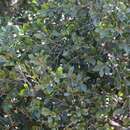pt-BR
nomes no trilho de navegação


Die Hardepeer (Olinia ventosa) is 'n boom wat voorkom in woude by lae hoogtes bo seespieël in die Oos- en Wes-Kaap. Die boom groei vinnig. Die bas is liggrys, skilfer dikwels af naby die basis van die stam en onthul dan 'n pienk-oranje binnebas. Die vrug word rooi wanneer dit ryp is en is ongeveer 10 mm in deursnee. Die naam van die boom verwys na die hardheid van die hout en nie die vrug nie. Die hout is liggeel tot grysbruin, het 'n fyn grein en egalige tekstuur.
Die Hardepeer (Olinia ventosa) is 'n boom wat voorkom in woude by lae hoogtes bo seespieël in die Oos- en Wes-Kaap. Die boom groei vinnig. Die bas is liggrys, skilfer dikwels af naby die basis van die stam en onthul dan 'n pienk-oranje binnebas. Die vrug word rooi wanneer dit ryp is en is ongeveer 10 mm in deursnee. Die naam van die boom verwys na die hardheid van die hout en nie die vrug nie. Die hout is liggeel tot grysbruin, het 'n fyn grein en egalige tekstuur.
Olinia ventosa (amb el nom comú en anglès de Hard Pear) és un gran arbre de fulla persistent originari d'Àfrica del Sud.
Les seves fulles expremudes fan olor d'ametlles amargants (contenen prunasina.[1])
Olinia ventosa (amb el nom comú en anglès de Hard Pear) és un gran arbre de fulla persistent originari d'Àfrica del Sud.
Les seves fulles expremudes fan olor d'ametlles amargants (contenen prunasina.)
Olinia ventosa ist eine Pflanzenart in der Familie der Penaeaceae aus Südafrika.
Olinia ventosa wächst als immergrüner, recht schnellwüchsiger Baum bis zu 25 Meter hoch. Der Stammdurchmesser erreicht über 1 Meter. Es sind oft Wurzelanläufe vorhanden oder der Stamm ist geriffelt. Die bräunliche bis gräuliche Borke ist im Alter rissig, furchig und abblätternd bis schuppig.
Die einfachen und kurz gestielten Laubblätter sind gegenständig. Der kurze Blattstiel ist bis 8 Millimeter lang. Die ledrigen Blätter sind ganzrandig, kahl und eiförmig bis verkehrt-eiförmig, spatelförmig oder elliptisch, mit keilförmiger, herablaufender Basis. Sie sind unterseits heller, bis 8 Zentimeter lang und abgerundet spitz bis zugespitzt oder stumpf, seltener eingebuchtet und teils feinstachelspitzig. Die Nebenblätter sind winzig.
Die zerquetschten Blätter und das frisch geschnittene Holz duften stark nach Mandeln.
Es werden achselständige, kurze und rispige Blütenstände mit zymösen Gruppen gebildet. Die duftenden, zwittrigen und 4–5-zähligen, kurz gestielten Blüten mit doppelter Blütenhülle sind weiß. Die sehr kleinen, schuppenförmigen, gefärbten und behaarten Kronblätter sitzen am röhrigen, oben feinzähnigen (mögl. Außenkelch), kahlen Blütenbecher. Die ausladenden, schmalen, petaloiden Kelchblätter sind spatelförmig und bespitzt. Die sehr kurzen Staubblätter sitzen oben in der Blütenbecherröhre am „Schlund“. Der mehrkammerige Fruchtknoten ist unterständig mit kurzem, eingeschlossenem Griffel und großer, kopfiger Narbe. Die Blüten werden manchmal durch Insekten infiziert und entwickeln Gallen.
Die kleinen, rötlichen, urnenförmigen und oft ein- bis mehrsamigen, -kammerigen, dünnfleischigen, steinfruchtartigen Früchte mit einer runden Blütenbechernarbe sind bis 7–10 Millimeter groß. Der mehrkammerige „Steinkern“ ist holzig. Die kleinen, beigen Samen sind halbmondförmig mit keilförmigen Querschnitt.
Das harte, schwere und beständige Holz ist gesucht. Es ist bekannt als Hard pear.
Olinia ventosa, commonly known as the hard-pear. is a large, evergreen forest tree indigenous to South Africa.
The hard-pear is a large tree that usually grows to 15–20 meters in height. When exposed to harsh conditions, it forms a smaller tree or shrub.
The bark is originally smooth and grey, but it becomes rough, flaky, fissured and reddish as the tree matures. The leathery, dark green, glossy leaves appear in opposite pairs, while the pinkish-white, fragrant, bisexual flowers appear in bunches at branch ends in the spring.
The tree very occasionally bears pinkish-red berries.
The hard-pear can sometimes be identified by the strong smell of almonds given off by the crushing of its leaves.
Olinia ventosa is a native of the southern and eastern coastal regions of South Africa, from the Cape Peninsula to southern KwaZulu-Natal. Its natural habitat is afro-montane forests, especially the forest margins, as well as coastal scrub and rocky hillsides.
It is now increasingly cultivated throughout South Africa, as a hardy and attractive shade tree for large gardens.
It is very fast-growing, hardy and able to tolerate poor and stony soils. As with most trees, it should not be planted too close to buildings or paved areas. Seeds are readily produced in the fruits, but are difficult to germinate, having a very tough coating that first needs to be removed. Once germinated, the young plants grow very rapidly.
While its wood has historically been valued for furniture-making, its primary use now is as a large shade tree for South African gardens. It is frequently planted for its aesthetic value, with its dense, dark foliage contrasting nicely with the bunches of pinkish-white flowers.[1]
Leaves contain the cyanogenic glucoside prunasin.[2]
Olinia ventosa, commonly known as the hard-pear. is a large, evergreen forest tree indigenous to South Africa.